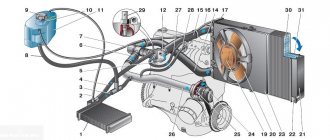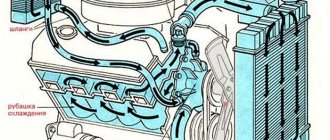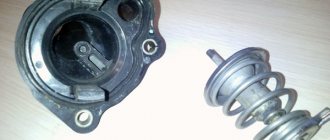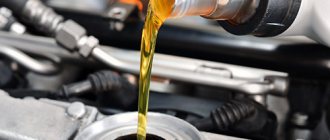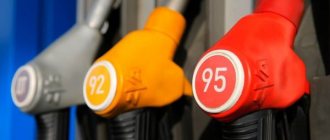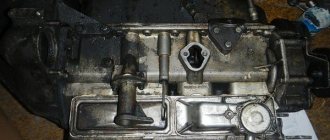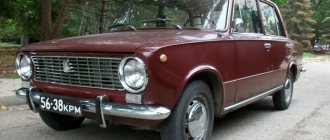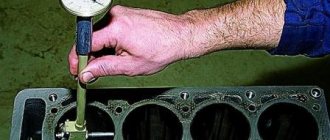CAUSES OF ENGINE OVERHEATING
Overheating can be caused by many reasons, all of them are related to a malfunction of the cooling system, or the quality of the coolant, as well as contamination of the cooling system jacket, which impairs the fluid throughput. It is important to use high-quality spare parts, otherwise the reasons below will happen suddenly. Let's look at each of the reasons.
LOW COOLANT LEVEL
The most common problem is a lack of coolant in the system. Coolant, in the form of antifreeze or antifreeze, constantly circulates through the system, removing heat from heated engine parts. If the coolant level is insufficient, the heat will not be removed sufficiently, which means an increase in temperature will be inevitable.
If it is not possible to add coolant, then turn on the heater to reduce the likelihood of overheating. As a last resort, add regular or distilled water, after which the cooling system must be flushed and then filled with fresh antifreeze. At temperatures above 90 degrees, you should immediately stop the car, turn off the ignition, and allow the engine to cool.
ELECTRIC COOLING FAN FAILED
The electric fan forces cool air onto the radiator, which is especially necessary when driving at low speeds when there is insufficient air flow. The fan can be installed either in front or behind the radiator. If the temperature arrow starts to rise, stop the car and check the fan for serviceability. Reasons for fan failure:
- electric motor failed
- connector oxidized
- fan relay burnt out
- The internal combustion engine temperature sensor has failed.
To check the fan, remove the connectors from it and connect the wires directly to the battery, which will allow you to determine the cause of the failure.
THERMOSTAT FAULT
The thermostat is one of the main elements of the cooling system. The cooling system has two circuits: small and large. A small circuit means that fluid circulates only through the engine. In a large circuit, fluid circulates throughout the system. The thermostat helps you quickly reach and maintain operating temperature. Thanks to the sensitive element, which opens the valve at 90 degrees, the liquid enters a large circle, and vice versa. The thermostat is considered faulty in two cases:
- operating temperature of the coolant is not reached
- the power unit tends to overheat.
Engine characteristics.
The power units used on Datsun have proven themselves over several years of operation. The characteristics of this equipment fit perfectly into the concept of the car, giving it the necessary level of performance indicators.
Engine VAZ 11183.
The VAZ engine 11183 was developed for installation on the Lada Kalina and cars of the corresponding class.
The design was based on the VAZ 21114 variant, which was equipped with earlier models. To obtain the required level of performance, specialists carried out a deep modification of the design. She touched:
- cylinder block height - an increase of 2.3 mm made it possible to obtain a larger working volume;
- crankshaft crank radius - to comply with the new block dimensions, it had to be increased by 2.3 mm, due to which the piston stroke increased;
- the shape of the combustion chamber - it is optimized in terms of limiting the compression ratio.
These and other developments have made it possible to obtain an economical and reliable unit with a high level of performance and the following characteristics.
Design:
- The arrangement of the cylinders in the block is in-line;
- Installation – transverse;
- Number of cylinders – 4;
- Operating procedure – 1342;
- Number of valves - 8 (adjustable valves, without hydraulic compensators);
- Cylinder diameter - 82 mm;
- Piston stroke - 75.6 mm;
- Working volume - 1596 cc;
- Compression ratio – 9.8.
Fuel and lubricants:
- Type – gasoline, atmospheric;
- Recommended fuel is unleaded gasoline with an octane rating of 92 or 95.
- Power supply – distributed injection system with microprocessor control (injector);
- The amount of oil in the lubrication system is 3.5 l. (when replacing 3.2 l.).
- Recommended lubricants - viscosity class according to SAE J30, depending on winter temperature, for most Russian territories - 5W-40, 10W-30, 10W-40, 15W-40.
- Oil consumption – 0.3% of fuel consumption.
- Fuel consumption for Datsun on-Do (mi-Do) with 5-speed manual gearbox per 100 km (city/highway/combined cycle) – 9.6/ 6.1/ 7.4 liters.
Thrust-to-weight ratio:
- Power (max) – 60 kW / 82 hp. at a rotation speed of 5200 rpm.
- Torque (max) – 132 Nm at a rotation speed of 2700 rpm.
Dynamics:
- Maximum speed 165 km/h;
- Acceleration time when starting from a standstill to 100 km/h is 12.9 s.
Resource - 200 thousand kilometers.
The power unit currently remains unclaimed due to a lack of power, which is evidenced by the dynamic performance of the car.
Engine VAZ 11186.
This internal combustion engine is almost identical to the previous one, however, due to its better thrust-to-weight ratio, it is used more widely. It was and is installed on Kalinas and Grants, and is included in both budget Datsun models.
The developers achieved improved performance by modifying the firmware and using lightweight connecting rods and pistons.
As a result, the following changed:
Fuel consumption indicators - per 100 km (city/highway/combined cycle) required:
- In the configuration with 5 speed manual gearbox - 9.0/ 5.8/ 7.0 l.
- In the configuration with 4 automatic transmission - 10.4/ 6.1/ 7.7 l.
Traction characteristics:
- Power (max) – 64 kW / 87 hp. at a rotation speed of 5200 rpm.
- Torque (max) – 140 Nm at a rotation speed of 2700 rpm.
Dynamic characteristics:
- Maximum speed for versions with 5-speed manual gearbox is 172 km/h, for vehicles with 5AT - 166 km/h;
- Acceleration time for configurations with a 5-speed manual transmission is 11.5 s, for vehicles with a 5AT – 14.4 s.
Engine 21127.
This powerful internal combustion engine, designed for installation on new Lada models (Granta, Priora, Vesta), is ideal for the Datsun on-Do configuration. Production of a model equipped with a new engine will begin in 2021.
It is distinguished from the power units discussed above:
- New electronics and firmware, in particular, throttle control from the ECU (electronic gas pedal).
- Increased power and traction characteristics.
- An improved gas distribution system - a dual timing shaft, 4 valves per cylinder (by the way, this is the first unit on domestic Datsuns for which the answer to the question of whether there are hydraulic compensators is positive).
- Design of intake and exhaust tracts, etc.
The engine exhibits the following characteristics.
Design:
- The arrangement of the cylinders in the block is in-line;
- Installation – transverse;
- Number of cylinders – 4;
- Number of valves -16 (4 valves per cylinder);
- Cylinder diameter - 82 mm;
- Piston stroke - 75.6 mm;
- Working volume - 1596 cc;
- Compression ratio – 10.7.
Fuel and lubricants:
- Type – gasoline, atmospheric;
- Recommended fuel is unleaded gasoline with an octane rating of 95, 92 is allowed.
- Power supply – microprocessor-controlled injection system (injector);
- The amount of oil in the lubrication system is 3.5 l.
- Recommended lubricants - viscosity class according to SAE J30, depending on winter temperature, for most Russian territories - 5W-40, 10W-30, 10W-40, 15W-40.
- Oil consumption – 0.3% of fuel consumption.
- Fuel consumption for a Datsun on-Do with 5-speed manual gearbox per 100 km (urban / suburban / mixed cycle) - 8.5 / 5.6 / 6.6 liters.
Traction characteristics:
- Power (max) – 78 kW / 106 hp. at a rotation speed of 5800 rpm.
- Torque (max) – 148 Nm at a rotation speed of 4200 rpm.
Dynamics:
- Maximum speed 184 km/h;
- Acceleration time when starting from a standstill to 100 km/h is 10.5 s.
Resource - 200 thousand kilometers.
CAUSES OF LOW ENGINE TEMPERATURE
Low engine temperature may occur in the following cases:
- use of an inappropriate thermostat (opening temperature too early)
- high performance of cooling fans, or their forced operation from the moment the engine starts
- thermostat malfunction
- non-compliance with the proportion of mixing antifreeze with water.
If you purchase antifreeze concentrate, it must be diluted with distilled water. If in your region the temperature has dropped to a maximum of -30°, then purchase antifreeze marked “-80” and dilute it 1:1 with water. In this case, the resulting liquid will heat and cool in time, and will not lose its lubricating properties, which is extremely necessary for the pump.
Source
VAZ-21127
The development of the famous engine, designed by engineers of the Tolyatti plant, under the label VAZ-21126, became the new power unit VAZ-21127. This is the most powerful 16-valve engine available for purchase with the Datsun mi-DO and on-DO. By installing an intake receiver with a variable length, the manufacturer managed to increase the power of the unit to 106 horsepower. This engine has the same block from the VAZ-21083 with an in-line arrangement of four cylinders with a diameter of 82 mm and a piston stroke of 75.6 mm. Gas distribution mechanism with camshaft drive from a belt. A special feature of this power unit is an intake system with a resonance chamber capable of regulating volumes. The principle of its operation lies in the different directions of the supplied air and its quantity. At low speeds it enters through a resonance chamber, and at high speeds it goes along a long path. With this solution, the manufacturer managed to increase the efficiency of fuel combustion and reduce actual consumption.
Another innovation of the engine is that it does not have a mass air flow sensor, instead of which DBP+DTV is now installed. Now there is no annoying problem associated with floating speed and sudden engine shutdown. As for the dynamic characteristics of the engine, it feels like it pulls better from the bottom; at the top you can feel a slight, but still, increase. In a word, a car with this engine drives much more interesting. In the gas distribution mechanism, the Gates belt is quite reliable and durable, with automatic tensioners. In general, in fact, this is a traditional VAZ engine with some features unique to it. The service life has been increased a little, and now with good maintenance the engine is capable of running 250 thousand kilometers without a single major repair. But timely replacement of the oil along with the filter is important, and the oil must be of high quality. However, breakdowns are possible, and they can be as follows:
- Sometimes it troits. We check spark plugs and fuel injectors. If the spark plugs, coil, and wires are in good condition, wash the injectors. The problem is often solved this way.
- Weak tension roller. The timing belt is reliable, but the pulley sometimes fails. If it jams, the belt will break; pistons with holes began to be installed after 2021.
- Still weak thermostat. Recently, the quality of domestic parts and mechanisms has increased, but the problem still remains, so various early breakdowns often occur. A broken thermostat will lead to overheating, which is undesirable and often detrimental to the engine.
What can you say in conclusion? The service life of the Datsun mi-DO and on-DO engine is limited by the actions of the car owner and some design weaknesses and shortcomings. The 16-valve 1.6-liter engine began to work more elastically, the dynamic properties of the car increased, and the problem with floating speed was almost completely resolved.
Posts 1 to 25 of 141
1 Topic by d_shama 04/15/2015 08:13:16
- d_shama
- Participant
- Inactive
- From: Elektrostal
- Messages: 55
- Thank you: 2
Topic: Engine overheating or underheating?
Yesterday while I was loading the car it was idling. No more than 10 minutes have passed and I get into the car and the engine temperature is already 100 degrees. Then I drove at different speeds, but as soon as you start driving slowly the temperature rises very quickly. And it's still cool outside. What will happen in the summer? I also wanted to ask at what temperature do our fans turn on? I noticed that the fan located on the inside of the radiator turns on at a temperature of 101 degrees and turns off at about 99 degrees. There is also a fan on the outside of the radiator. It doesn't turn on at all. What is it even for? And what is our operating temperature? Maybe my contact has come loose somewhere?
2 Reply from max-xx 04/15/2015 08:26:39
- max-xx
- Moderator
- Inactive
- From: Moscow
- Messages: 2,888
- Thank you: 375
Re: Engine overheating or underheating?
102 degrees temperature for turning on the cooling fan on the b/c dashboard. It turns off at about 97. External fan - air conditioning system. When the air conditioner is turned on, it always rotates. Therefore the temperature drops to 83 degrees with it.
3 Reply from d_shama 04/15/2015 08:35:13
- d_shama
- Participant
- Inactive
- From: Elektrostal
- Messages: 55
- Thank you: 2
Re: Engine overheating or underheating?
I had the climate control turned on but was blowing warm air (no air conditioning). So everything is okay?
4 Reply from albertini78 04/15/2015 09:05:25
- albertini78
- Participant
- Inactive
- Messages: 59
- Thank you: 4
Re: Engine overheating or underheating?
I had the climate control turned on but was blowing warm air (no air conditioning). So everything is okay?
5 Reply from max-xx 04/15/2015 09:24:05
- max-xx
- Moderator
- Inactive
- From: Moscow
- Messages: 2,888
- Thank you: 375
Re: Engine overheating or underheating?
Yes. Everything is fine. If the air conditioning turned on, you would feel it not only by the green button.
6 Reply from kdesealmi 04/15/2015 09:48:38
- kdesealmi
- Participant
- Inactive
- From: Astrakhan
- Messages: 59
- Thank you: 4
Re: Engine overheating or underheating?
My cooling fan turns on/off very often. The temperature is around 85 degrees. Any thoughts?
7 Reply from d_shama 04/15/2015 10:05:10
- d_shama
- Participant
- Inactive
- From: Elektrostal
- Messages: 55
- Thank you: 2
Re: Engine overheating or underheating?
But for me it turns on only at a temperature of 101 degrees. Do we have different damn cars?
8 Reply from 7TT 04/15/2015 11:02:32
- 7TT
- Participant
- Inactive
- From: Orenburg
- Messages: 690
- Thank you: 58
VAZ-11186
The history of the VAZ-11186 engine, created in 2011, goes back to engines designed specifically for cars with a transverse power unit of the VAZ-2108 family. In fact, this engine is a modernized version of the VAZ-11183: the manufacturer has lightened the piston group. The engine is based on a 4-cylinder cast iron cylinder block of in-line architecture, an 8-valve cylinder head with a single camshaft. The cylinders are bored to 82 mm, and the piston travels 75.6 mm. The engine power is 87 hp and the maximum torque is 140 Nm. In the drive of the gas distribution mechanism there is a belt. However, recently the manufacturer decided to reduce the width of the belt. Therefore, there are certain questions about its reliability. However, this question applies not only to the timing belt, but to the entire engine as a whole.
The spirit of modern engine building is felt - a short piston skirt. In addition, the supporting surface of the piston is small, the connecting rods have become noticeably thinner compared to previous engines. The piston is lightened to the limit. Due to these and many other changes (modified intake and exhaust manifolds), it was possible to increase power figures and bring the engine up to Euro-4 standards. But the modernizations carried out did not include the usual holes for valves in the pistons, so if the timing belt breaks, the valves will bend with an almost 100% guarantee. However, this was the case until 2021: starting from 2021 production and later, the VAZ-11186 engine with holes for pistons. It’s also good that the VAZ-11186 is equipped with a fairly reliable Gates belt with automatic adjustment. As practice shows, it is capable of operating for about 150 thousand kilometers or more.
Since there are no hydraulic compensators, in some cases the engine can be quite noisy. Knocks and noises coming from the engine compartment are quite common. In the best case, the thermal gaps will have to be adjusted. If they are adjusted, you need to look at the piston group and main liners. When the engine makes noise at 200-220 thousand km, there is a high probability that a costly overhaul will be required. The cast iron block allows for repeated boring of the cylinders to repair sizes; in general, there are no difficulties with its restoration today. The design of the valve drive is such that, in comparison with the engines on the Hyundai Solaris or Kia Rio, it requires quite frequent adjustments.
Frequent faults:
- The engine may stall while driving. VAZ car owners know well that if the engine stalls, you need to look at the mass air flow sensor.
- Thermostat. In this engine, just like in the VAZ-11183, the thermostat often fails, which leads to malfunctions of the cooling system.
- Weak pump and tension roller. The rollers and coolant pump have always been considered the weak points of front-wheel drive VAZ cars. Engine maintenance culture also plays an important role here. Many car owners pour some water, some fake antifreeze, and this is critical for the oil seal and pump bearing. There are even cases where low-quality coolant caused the destruction of pump blades. The tension and idler rollers of the timing drive can lead to shearing of the timing belt teeth. Partly for this reason, in 2018 they switched to “stickless” pistons.
Although the manufacturer has made attempts to bring the engine up to modern standards, its design remains largely outdated. In addition, it was not possible to get rid of some weaknesses and “diseases”, such as, for example, an unreliable coolant pump along with rollers. Significant advantages include fairly inexpensive maintenance and the possibility of multiple repairs.
